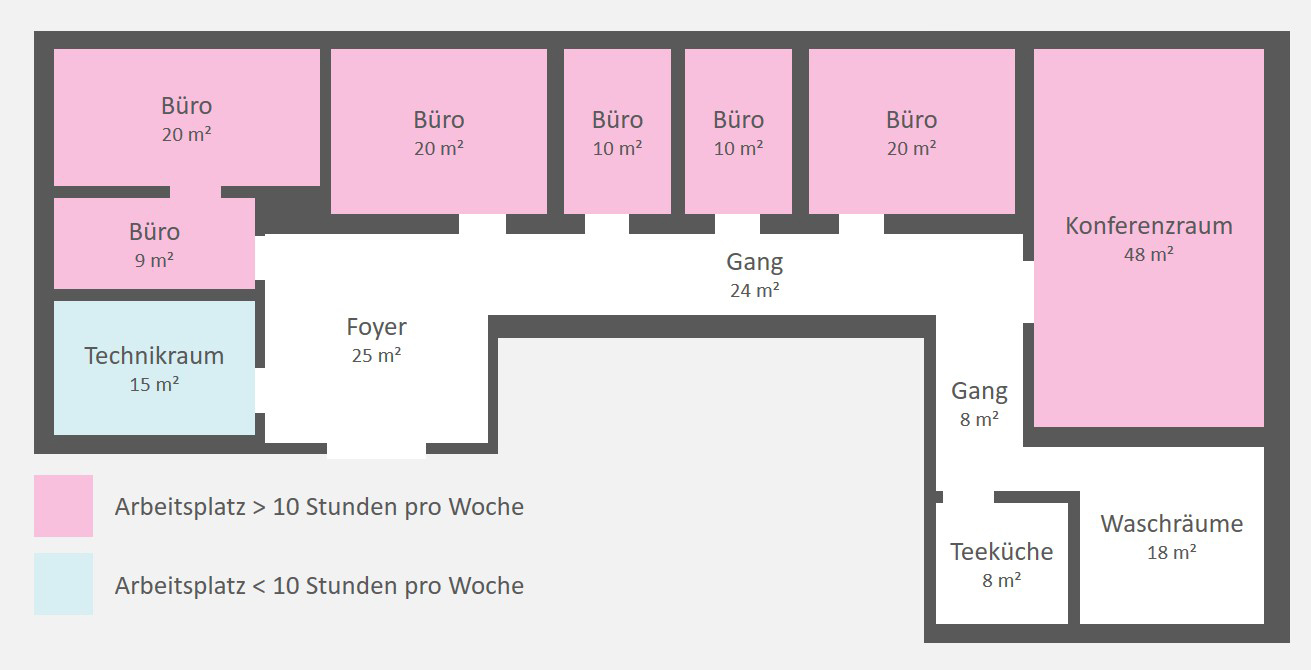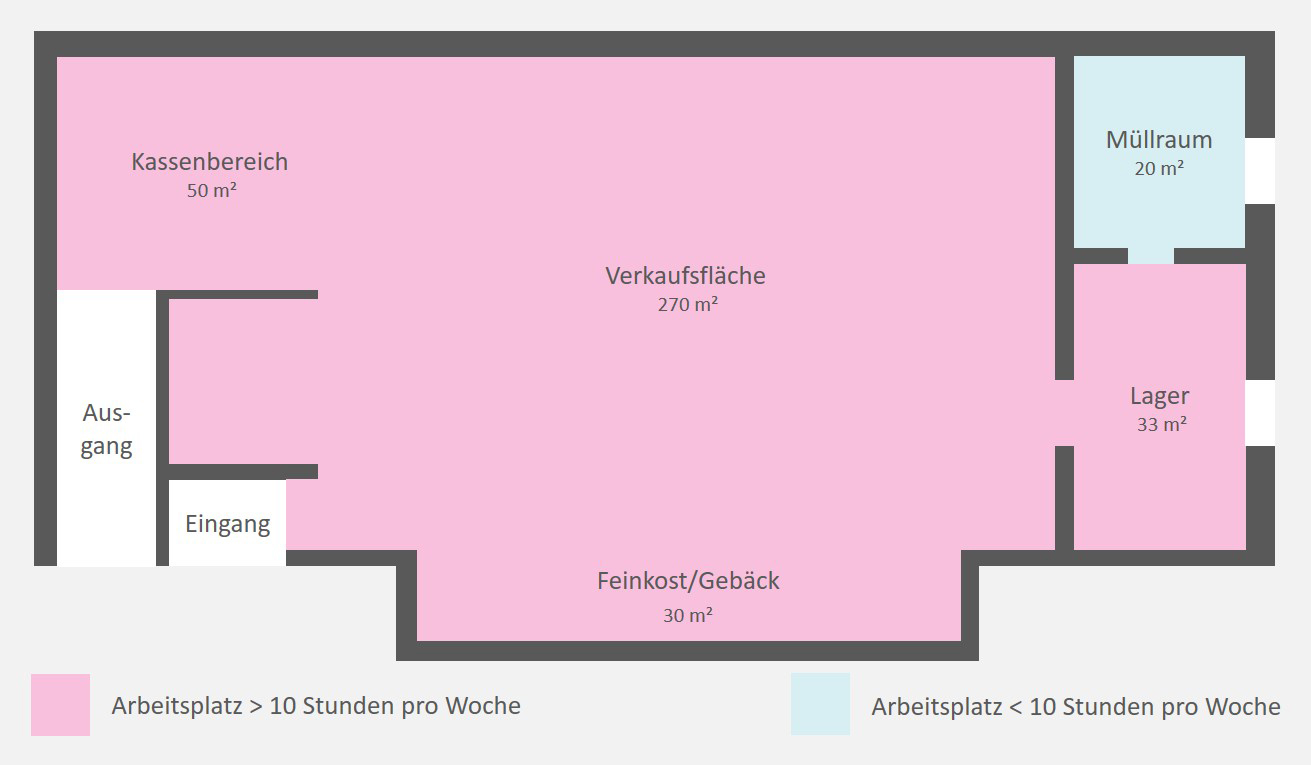Obligations in radon protection areas Measurement obligation at workplaces in radon protection areas on the ground floor and in basements
In Austria, there are areas in which high indoor radon concentrations are likely to occur due to the properties of the soil. These areas have been designated as radon protection areas. The affected municipalities are listed in Annex 1 of the Radon Protection Ordinance and shown on the radon map. In order to reduce the health risk from radon, employers in radon protection areas are obliged to measure the radon concentration in certain workplaces.
Obligations for employers
Your company falls within the scope of radon protection in the workplace if the following points apply:
- the business/operating site is located in a radon protection area
- Workplaces are located on the ground floor or in basements
If both apply, you are obliged to carry out a radon measurement at the affected workplaces. The aim of the radon measurement is to check whether the reference value for the radon concentration at the workplace is complied with in all relevant work areas.
Before commissioning the measurement, clarify whether an exception applies to your workplaces, which are generally subject to a measurement obligation.
Exemptions from the measurement obligation
Workplaces where at least one of the following conditions applies are exempt from the measurement obligations of the Radiation Protection Act 2020:
- You do not employ any workers at these workplaces
- the workplaces are located in private households
- employees do not spend more than ten hours per week (averaged over one year) at the workplace
- the building components and component transitions in contact with the ground as well as the penetrations and openings through building components and component transitions in contact with the ground of the building are designed against pressing water
- there is a state-of-the-art radon drainage system that covers the entire building
- the workplaces are separated from the ground by a permanently ventilated storey (e.g. underground car park)
If at least one exception applies to all workplaces of a business or business premises, the competent radiation protection authority must be notified of this in writing. The competent authority is the provincial governor, represented by the respective provincial government office. This means that no further obligations apply.
Determination of the radon concentration
You must arrange for a radon measurement for all workplaces for which no exemption requirement applies. The radon concentration indoors can be measured easily, reliably and inexpensively. The number of measurements required depends on the number of workplaces located on the ground floor and in the basement.
According to the Radon Protection Ordinance, radon measurements must be carried out by an authorized monitoring body. Here you will find a list of those authorized according to the Radiation Protection Act 2020authorized monitoring bodiesThe measurement period is at least six months and must be carried out at least half of the time between October 15 and April 15. Good time intervals for carrying out the measurement are either mid-December to the end of June or mid-July to the end of January. The authorized monitoring body commissioned by you will inform you about what needs to be observed during the radon measurement.
The aim of this measurement is to check whether the reference value for the radon concentration in the workplace is complied with in all relevant work areas. The reference value for the radon concentration in the workplace is 300 becquerels per cubic meter (Bq/m³).
In this example company, there are no requirements for exceptions to the measurement obligation that affect the entire building. Workstations are located in all offices as well as in the conference room and the technical room. There are two workstations in each of two 20 m² offices. There are several workstations in the conference room. There are no workstations in the foyer, in the corridor, in the kitchenette and in the washrooms.
Radon measurements required:
- In the case described, a radon measurement is required in each of the offices (six radon measuring devices).
- The average time spent in the conference room and the technical room is decisive.
- The technical room is used as a workplace for five hours per week (annual average). Therefore, one of the conditions for the exemption from the measurement obligation applies: this room does not have to be measured.
- The conference room is used as a workplace for 20 hours per week (annual average). Therefore, no requirement for exemption from the measurement obligation applies. This room must be measured.
Result: Example 1 requires seven measurements.
Note: If offices are empty for a longer period of time - for example because an employee leaves the company - the person responsible does not employ anyone at this workplace. In this case, one of the conditions for exemption from the measurement obligation applies.
In this example business, there are no requirements for exemptions from the measurement obligation that affect the entire building. Workplaces are located in the checkout area and the delicatessen/bakery counter, on the sales floor, in the warehouse and in the waste room. Different employees work at each of the workplaces.
Radon measurements required:
- The sales area forms one room together with the checkout and delicatessen/pastry counter areas. The area of the room is 350 m². Therefore, one measurement is not sufficient for all workplaces located in this room because the floor area of the room is more than 150 m².
- If the room is divided into areas of less than 150 m², this results in three areas. Three measurements are therefore required. These should now be positioned in such a way that they take into account, on the one hand, the time spent by the employees and, on the other hand, the division of the room into three areas. Comparatively long dwell times of employees occur in the checkout area and in the delicatessen/bakery counter. A measurement should therefore be carried out in each of these areas. The third radon measuring device should be set up in the sales area, whereby a sensible distance should be maintained from the checkout and delicatessen/bakery counter areas.
- The average time spent in the warehouse and in the waste room is decisive.
- The waste room is used as a workplace for five hours per week (annual average). Therefore, a prerequisite for the exemption from the measurement obligation applies. This room does not have to be measured.
- The warehouse is used as a workplace for 14 hours per week (annual average). Therefore, no requirement for exemption from the measurement obligation applies. This room must be measured.
Result: Example company 2 requires four measurements.
The rooms are located on the upper floors and are therefore not subject to the obligations for radon protection in the workplace. They are therefore not taken into account below.
In this example business, there are no requirements for exemptions from the measurement obligation that affect the entire building.
Workplaces are located in the reception, bar, restaurant, kitchen, building services and waste room in the basement. Different employees work at each of the workplaces. There are no workplaces in the staff changing room, in the stairwell and in the staff parking lots.
Radon measurements required:
- The reception forms one room together with the entrance hall and bar. The area of the room is 43 m². Therefore, one measurement is sufficient for all workplaces located in this room because the floor area of the room is less than 150 m². It makes sense to carry out the measurement in the area where the employees spend the most time.
- In the restaurant, one measurement is sufficient for all workstations located in this room because the floor area of the room is less than 150 m².
- In the kitchen, one measurement is sufficient for all workstations located in this room because the floor area of the room is less than 150 m².
- In the room for building services and in the waste room, the average time spent in the room is decisive.
- The waste room is used as a workplace for seven hours per week (annual average). Therefore, one requirement for the exemption from the measurement obligation applies. This room does not have to be measured.
- The building services are used as a workplace for 12 hours per week (annual average). Therefore, no requirement for exemption from the measurement obligation applies. This room must be measured.
Result: Example company 3 requires four measurements.
Measurement result below the reference value
If the radon concentration determined at all workplaces is below the reference value of 300 Bq/m³, no further measures are necessary.
Note: Structural changes to the building can lead to an increase in the radon concentration. A new radon measurement is therefore necessary after relevant structural changes have been made. These changes are described in more detail in Annex 4 of the Radon Protection Ordinance.
Result above the reference value: You can find more information here.


